Key Takeaways
- Drive employee engagement: Learn how to develop and conduct employee surveys to foster engagement, boost morale, and create a positive work environment.
- Unlock valuable insights: Discover step-by-step strategies for survey design, implementation, and analysis, enabling you to uncover meaningful insights and make data-driven decisions.
- Take action for organizational success: Turn survey feedback into impactful change by developing action plans, engaging stakeholders, and monitoring progress. Transform your organization and drive lasting success.
Welcome to the magical realm of employee surveys.
Are you ready to embark on an enchanting journey where you’ll learn how to sprinkle survey stardust and unveil the hidden desires of your workforce?
Well, you’ve come to the right place.
Now, you might be thinking, “What’s the big deal about employee surveys? Are they really that important?”
Picture this: You’re the ruler of an imaginary kingdom called “Companyland,” and you want to ensure your employees are content, motivated, and bursting with productivity.
The key to unlocking this utopian paradise lies in the realm of employee surveys.
But why are employee surveys so crucial, you ask?
Imagine running a company where everyone is as happy as a clam, where teamwork flows like chocolate fountains, and where employees feel valued and heard.
Sounds like a fairytale, right?
Well, employee surveys are your magic wand to make it all happen.
Now, let’s be clear: we’re not suggesting you transform your office into a mystical land populated with unicorns (although that would be pretty cool).
But by developing and conducting employee surveys, you’ll gain insights into your employees’ thoughts, feelings, and experiences.
It’s like peeking into the looking glass of their minds and understanding what makes them tick.
So, whether you’re a wise wizard of human resources, a courageous manager on a mission, or an ambitious employee seeking to make a difference, this comprehensive guide will equip you with the knowledge and tools to create stellar employee surveys that unlock the secrets to workplace bliss.
But beware, dear reader.
This guide is not your average potion recipe. It’s packed with humor, wit, and a sprinkle of fairy dust to keep you entertained while you embark on this noble quest.
So, grab your quill, saddle up your unicorn, and let’s dive into the mystical world of employee surveys.
In the next section, we’ll prepare for our adventure by defining our survey objectives, identifying key areas of interest, and even choosing the right survey methodology.
Remember, even the bravest knights need a plan before storming the castle.
Stay tuned, my fellow survey sorcerers, for we are about to unlock the secrets of creating employee surveys that will enchant your organization and transform it into a realm of unicorns and happy employees.
Before we venture further into this article, we like to share who we are and what we do.
About 9cv9
9cv9 is a business tech startup based in Singapore with a strong presence worldwide.
With over six years of startup and business experience, and being highly involved in connecting with thousands of companies and startups, the 9cv9 team has listed some important learning points in this overview of how to do the perfect Employee Survey.
If you are looking for a high-salary job or for a remote job, then hop over to 9cv9 Job Portal to find your next job and internship.
How to Develop and Conduct Employee Surveys
- Preparing for Employee Surveys
- Designing Effective Employee Surveys
- Ensuring Survey Participation and Confidentiality
- Implementing and Conducting the Employee Survey
- Analyzing and Interpreting Survey Data
- Taking Action Based on Survey Insights
- Monitoring Progress and Conducting Follow-Up Surveys
1. Preparing for Employee Surveys
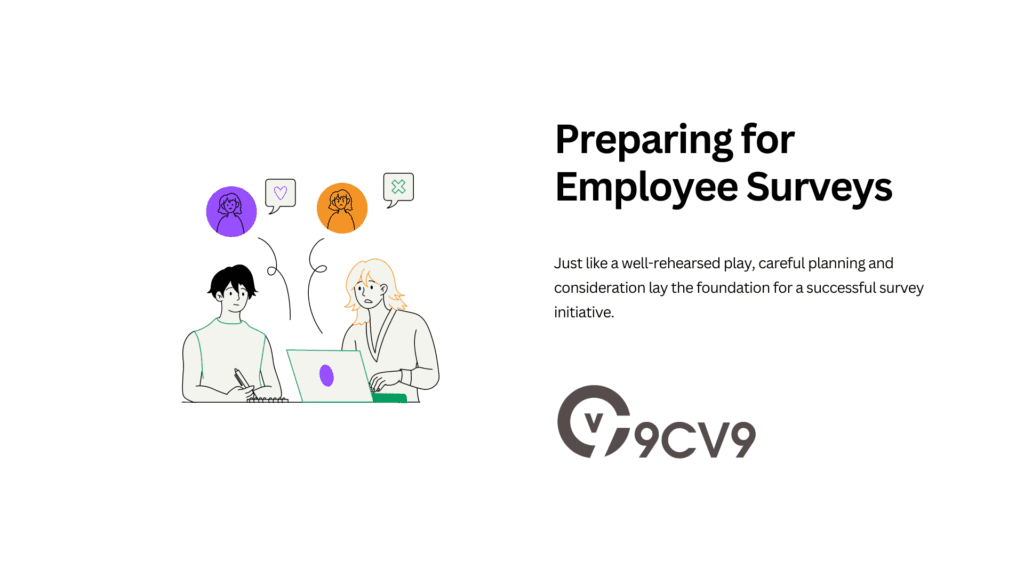
Before embarking on the exciting journey of conducting employee surveys, proper preparation is essential.
Just like a well-rehearsed play, careful planning and consideration lay the foundation for a successful survey initiative.
In this section, we will guide you through the key steps to prepare for employee surveys, ensuring a smooth and fruitful process.
Step 1: Defining Survey Objectives and Goals – Setting the Compass
Every survey needs a clear purpose and direction.
Take a moment to reflect on what you aim to achieve with your employee survey.
Are you looking to gauge employee satisfaction, identify areas of improvement, gather feedback on specific initiatives, or measure engagement levels?
Defining your survey objectives will help you align your efforts and focus your questions effectively.
Step 2: Identifying Key Areas of Interest – The Building Blocks
To uncover valuable insights, it’s crucial to identify the areas of your organization that you wish to explore through the survey.
Consider various aspects, such as communication, work-life balance, organizational culture, leadership, career development, and employee well-being.
By pinpointing the key areas of interest, you can tailor your questions to gather meaningful data and address specific concerns.
Step 3: Determining Survey Methodology – Choosing the Right Path
Selecting the appropriate survey methodology is crucial to ensure optimal participation and data collection.
Evaluate your options: will you conduct an online survey, utilize paper-based surveys, or implement a hybrid approach?
Each method has its advantages and considerations.
Online surveys offer convenience, scalability, and ease of data analysis, while paper surveys might be suitable for specific employee populations or offline environments.
Consider the preferences and accessibility of your workforce when making this decision.
Step 4: Choosing the Right Survey Tool or Software – Empowering Efficiency
With a plethora of survey tools and software available, choosing the right one can streamline your survey process and enhance your data analysis capabilities.
Look for user-friendly platforms that offer features like survey design customization, data visualization, and robust analytics.
Consider factors such as ease of use, data security, integration options, and customer support.
Selecting a reliable tool that meets your specific requirements will simplify survey administration and analysis, saving you time and effort.
Step 5: Establishing a Realistic Timeline – Timing is Everything
Crafting a realistic timeline is essential for a smooth survey implementation.
Consider the time needed for survey development, testing, communication, and data analysis.
Allow for ample response time while balancing the need for timely data.
Communicate the survey timeline to employees to ensure they have sufficient opportunity to provide their valuable input.
A well-planned timeline promotes engagement and maximizes participation rates.
By following these preparatory steps, you lay the groundwork for a successful employee survey initiative.
Clear objectives, identified areas of interest, appropriate survey methodology, the right survey tool or software, and a realistic timeline are the key elements that set the stage for a fruitful data collection process.
In the next section, we will delve into the art of crafting effective survey questions that resonate with your employees and elicit meaningful responses.
Stay tuned as we unravel the secrets to designing survey questions that unlock valuable insights and pave the way for actionable outcomes.
Prepare yourself for an enlightening journey of employee survey excellence.
2. Designing Effective Employee Surveys

Designing an employee survey that captures valuable insights requires skill, finesse, and a touch of creativity.
In this section, we will guide you through the process of crafting effective survey questions, selecting appropriate question types, ensuring a logical flow, and incorporating demographic questions.
Prepare to embark on a journey of survey design mastery.
Step 1: Crafting Clear and Focused Survey Questions – The Art of Precision
The key to extracting meaningful data lies in crafting clear and focused survey questions.
Avoid vague or ambiguous language that can lead to confusion or misinterpretation.
Use concise and specific wording to ensure respondents understand the intent of each question.
Remember, simplicity is your ally when it comes to survey comprehension and data accuracy.
Step 2: Selecting Appropriate Question Types – A Palette of Diversity
Your survey questions should employ various question types to capture different aspects of employee experiences.
Multiple-choice questions offer predefined response options and are useful for gathering specific feedback.
Likert scale and rating scale questions enable respondents to rate their agreement or satisfaction levels.
Open-ended questions invite participants to provide qualitative insights, capturing rich narratives and suggestions.
Utilize a combination of these question types to obtain a comprehensive view of employee sentiments.
Step 3: Creating a Logical Flow and Structure – The Symphony of Order
A well-structured survey flows smoothly, guiding participants through a logical sequence of questions.
Begin with easy and engaging questions to encourage participation, gradually progressing to more detailed or sensitive topics.
Group related questions together to maintain coherence and aid respondents in understanding the context.
Use clear section headings and numbering to enhance survey navigation.
By orchestrating a seamless flow, you ensure participants remain engaged and focused throughout the survey journey.
Step 4: Incorporating Demographic Questions – The Mosaic of Insights
Demographic questions provide valuable context and help analyze survey responses across different employee segments.
Include demographic inquiries such as age, gender, department, tenure, or job level.
These demographic factors can be useful for segmenting data and identifying patterns or discrepancies among employee groups.
Ensure, however, that your demographic questions are relevant and align with your organization’s diversity and inclusion policies.
Step 5: Piloting and Testing the Survey – The Dress Rehearsal
Before launching your survey to the entire workforce, conduct a pilot test with a small group of employees.
This trial run allows you to identify potential issues, such as confusing questions or technical glitches.
Gather feedback from pilot participants to ensure clarity, relevance, and user-friendliness.
Refine your survey based on their input and make any necessary adjustments.
A successful pilot test sets the stage for a polished and effective survey instrument.
By following these design principles, you will create an employee survey that captures meaningful insights. Clear and focused questions, a variety of question types, a logical flow, demographic considerations, and pilot testing contribute to a well-crafted survey instrument.
In the next section, we will explore the best practices for ensuring maximum survey participation, confidentiality, and overcoming employee concerns.
Get ready to unlock the secrets of survey engagement and create a safe space for open and honest feedback.
Stay tuned as we journey deeper into the realm of employee surveys, where valuable insights await your discovery.
3. Ensuring Survey Participation and Confidentiality
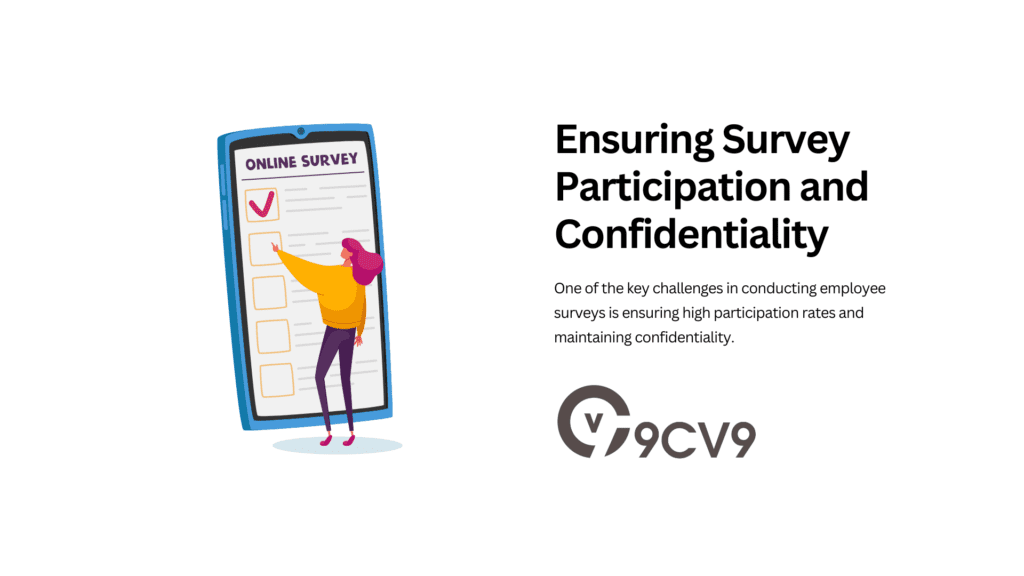
One of the key challenges in conducting employee surveys is ensuring high participation rates and maintaining confidentiality.
In this section, we will unveil strategies to encourage employees to participate actively in the survey process, while assuring them that their responses will be treated with utmost confidentiality.
Step 1: Communication and Transparency – The Bridge of Understanding
Effective communication is the cornerstone of survey participation.
Clearly communicate the purpose and benefits of the survey to your employees, emphasizing how their feedback contributes to positive changes within the organization.
Explain the confidentiality measures in place and assure employees that their responses will be anonymous and aggregated.
Be transparent about the survey process, including the timeline, data handling, and the actions that will be taken based on the results.
Address any concerns or questions proactively, building trust and engagement from the start.
Step 2: Management Support and Leadership Buy-In – The Beacon of Inspiration
Leadership endorsement plays a crucial role in fostering survey participation.
Encourage managers and executives to express their support for the survey, emphasizing its importance and their commitment to utilizing the feedback to drive positive change.
When employees see their leaders actively promoting and participating in the survey, it creates a sense of importance and trust.
Managers can also play a vital role in reminding and encouraging employees to complete the survey, fostering a culture of participation throughout the organization.
Step 3: Survey Accessibility and User-Friendliness – The Path of Convenience
Make the survey easily accessible and user-friendly to encourage participation.
Provide clear instructions on how to access and complete the survey, utilizing multiple channels such as email, intranet, or dedicated survey platforms.
Ensure that the survey interface is intuitive and responsive across different devices, allowing employees to complete it at their convenience.
Consider translating the survey into multiple languages if your workforce is multilingual, ensuring inclusivity and enabling broader participation.
Step 4: Incentives and Recognition – The Spark of Motivation
Sometimes a little motivation goes a long way in boosting participation rates.
Consider providing incentives or rewards for survey completion, such as gift cards, company merchandise, or even small gestures of appreciation like a team lunch or recognition in company communications.
These incentives can serve as a token of gratitude for employees’ time and effort, further motivating them to participate and provide honest feedback.
Step 5: Confidentiality and Data Security – The Vault of Trust
To encourage open and honest responses, reassure employees of the confidentiality and data security measures in place.
Clearly communicate that their individual responses will remain anonymous and confidential, and that only aggregated data will be analyzed.
Employ robust data protection practices, such as encryption and secure data storage, to instill confidence in employees that their information is safeguarded.
Adhere to privacy laws and regulations to ensure legal compliance and further reinforce the trustworthiness of the survey process.
By implementing these strategies, you can foster a culture of trust and engagement, encouraging maximum participation in your employee survey. Effective communication, management support, user-friendly accessibility, incentives, and a commitment to confidentiality build the foundation for a successful survey initiative.
In the next section, we will explore the art of analyzing survey data and deriving actionable insights. Get ready to unleash the power of data-driven decision-making as we uncover the secrets of survey analysis and interpretation.
Prepare yourself for the final stage of our surveying adventure, where the true magic of employee surveys awaits.
4. Implementing and Conducting the Employee Survey
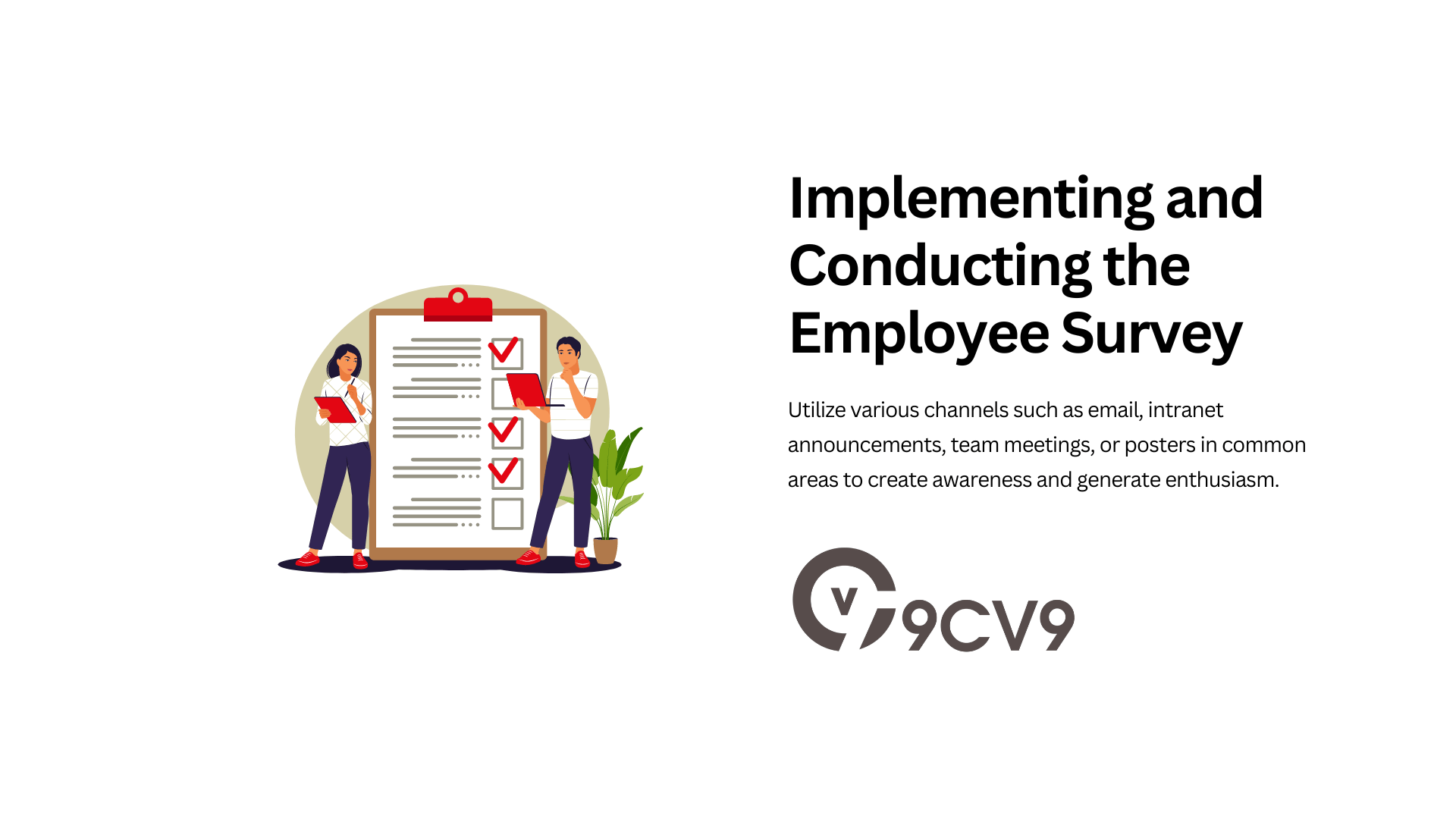
You’ve reached the enchanting stage of implementing and conducting your employee survey.
In this section, we will guide you through the practical steps of launching and administering the survey, ensuring a smooth and successful data collection process.
Let’s transform your surveying aspirations into a tangible reality.
Step 1: Launching the Survey – Spreading the Word
It’s time to cast your survey spell and let the magic begin.
Launch the survey by communicating its availability and importance to all employees.
Utilize various channels such as email, intranet announcements, team meetings, or posters in common areas to create awareness and generate enthusiasm.
Emphasize the value of each individual’s participation and their contribution to shaping the organization’s future.
Step 2: Reminders and Follow-ups – Gentle Nudges
Sometimes a friendly reminder can work wonders.
Send periodic reminders to employees who have not yet completed the survey, gently encouraging their participation.
Consider personalized follow-ups for specific teams or individuals who may need an extra nudge.
Keep the survey top of mind throughout the data collection period to maximize participation rates and ensure a representative sample.
Step 3: Data Collection and Survey Administration – Capturing the Essence
As the survey responses pour in, it’s crucial to maintain a systematic approach to data collection.
Monitor survey completion rates and identify any potential issues or discrepancies.
Ensure the survey administration process is efficient and error-free, with well-trained administrators available to address any technical or logistical concerns.
Regularly back up the survey data to prevent any loss or accidental deletion, treating the data as the precious gem it is.
Step 4: Monitoring Survey Progress – Tracking the Journey
Throughout the survey period, keep a close eye on the progress and response rates.
Monitor participation rates by department, location, or other relevant segments to identify any gaps and take targeted actions to improve representation.
Assess the quality of responses, ensuring that participants have answered all required questions and have provided thoughtful input.
Stay vigilant and responsive to any feedback or issues that arise during the survey administration phase.
Step 5: Closing the Survey and Expressing Gratitude – The Final Act
As the survey draws to a close, express your sincere appreciation to all employees who participated.
Communicate the survey’s impact and the next steps in the data analysis and action planning process.
Reiterate the importance of their contributions and how their feedback will drive positive changes within the organization.
Closing the survey on a positive note helps maintain engagement and sets the stage for future survey initiatives.
By following these implementation and administration best practices, you bring the magic of your employee survey to life. Launching the survey, sending reminders, ensuring smooth data collection, monitoring progress, and expressing gratitude create a seamless survey experience for both administrators and participants.
In the final section of our surveying adventure, we will explore the art of data analysis and transforming survey insights into actionable outcomes. Prepare to unlock the secrets of harnessing the power of employee feedback to drive organizational success.
The grand finale of our surveying journey is just around the corner.
Get ready to unveil the true power of data-driven decision-making.
5. Analyzing and Interpreting Survey Data
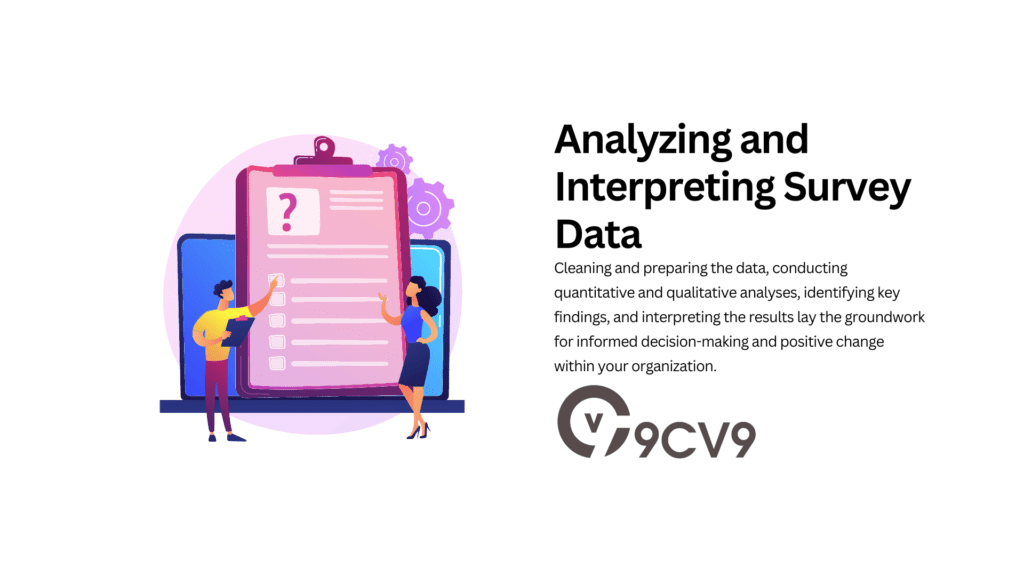
Welcome to the grand finale of our surveying adventure.
In this section, we will unravel the art of analyzing and interpreting survey data to unlock valuable insights and drive meaningful action.
Get ready to immerse yourself in the world of data-driven decision-making and transform your survey findings into actionable outcomes.
Step 1: Data Cleaning and Preparation – Polishing the Gem
Before diving into analysis, it’s essential to clean and prepare your survey data.
Review the responses for completeness, ensuring that all required questions are answered.
Remove any duplicate or erroneous entries. Organize the data in a structured format, ready for analysis.
This step sets the stage for accurate and reliable insights.
Step 2: Quantitative Analysis – Unveiling Patterns and Trends
Quantitative analysis allows you to uncover patterns and trends within the survey data.
Utilize statistical techniques such as mean, median, and mode to summarize numerical responses.
Explore frequency distributions and histograms to visualize the distribution of responses.
Use cross-tabulation to analyze relationships between different survey variables.
By delving into the quantitative aspects of your data, you can identify key themes and areas of focus for further exploration.
Step 3: Qualitative Analysis – Unearthing Rich Narratives
Qualitative analysis helps you unearth rich narratives and detailed insights from open-ended survey responses.
Categorize and code the qualitative data based on themes or topics that emerge.
Utilize techniques such as content analysis or sentiment analysis to identify prevailing sentiments or common themes.
Look for recurring ideas, suggestions, or concerns that provide deeper context and meaning to the quantitative findings.
The qualitative analysis adds depth and nuance to your survey insights.
Step 4: Identifying Key Findings – Illuminating the Gems
Once you have completed the analysis, identify the key findings that emerge from the data.
Highlight significant patterns, trends, or themes that have implications for your organization.
Look for areas of strength and areas that require improvement.
Pay attention to any unexpected or surprising findings that can offer new perspectives or opportunities for growth.
It’s these key findings that will serve as the foundation for actionable outcomes.
Step 5: Interpreting the Results – Transforming Insights into Action
Interpreting survey results involves making sense of the findings and translating them into actionable outcomes.
Consider the context of your organization, its goals, and the survey objectives.
Reflect on how the survey findings align with existing initiatives or identify new areas for improvement.
Prioritize the key findings and develop an action plan with specific steps and timelines.
Engage stakeholders, share the results, and foster a collaborative approach to implement changes based on the insights gained.
By following these data analysis and interpretation practices, you can transform your survey data into actionable outcomes.
Cleaning and preparing the data, conducting quantitative and qualitative analyses, identifying key findings, and interpreting the results lay the groundwork for informed decision-making and positive change within your organization.
Congratulations on completing the journey of employee surveys.
Armed with valuable insights, you are now ready to embark on a path of continuous improvement and success.
Remember, the true magic lies not only in collecting data but in using it to drive meaningful action.
May your survey findings ignite positive transformations and create a thriving work environment for your employees.
6. Taking Action Based on Survey Insights
Congratulations on reaching the pinnacle of your surveying adventure.
In this final section, we will explore the art of taking action based on survey insights.
Armed with valuable data and analysis, you are now poised to drive meaningful change within your organization.
Get ready to unleash the power of survey feedback and transform it into impactful action.
Step 1: Prioritizing Key Findings – Focusing on Impact
With a wealth of survey insights at your disposal, it’s essential to prioritize the key findings that have the most significant impact on your organization.
Identify the areas where change is most needed or where improvements can yield the greatest benefits.
Consider the alignment of these findings with your organization’s strategic goals and priorities.
By focusing on the most critical issues, you can direct your resources and efforts effectively.
Step 2: Engaging Stakeholders – Collaboration for Success
Effective action requires collaboration and engagement from all levels of the organization.
Share the survey results with key stakeholders, such as managers, department heads, or the leadership team.
Engage them in a dialogue about the findings and solicit their input on potential solutions.
Encourage open and honest discussions, allowing for diverse perspectives and ideas to emerge.
By involving stakeholders from the start, you create a sense of ownership and commitment to driving change.
Step 3: Developing Action Plans – From Insight to Execution
Transforming survey insights into actionable outcomes requires well-defined action plans.
Break down each key finding into specific initiatives or projects.
Assign responsibilities and set clear timelines for implementation.
Ensure that the action plans are SMART (Specific, Measurable, Achievable, Relevant, and Time-bound) to facilitate accountability and progress tracking.
Consider allocating resources and budget as needed to support the implementation of the action plans.
Step 4: Communication and Transparency – Keeping the Momentum
Effective communication is vital to maintaining momentum and ensuring the success of your action plans. Regularly update employees on the progress of the initiatives and the impact they are making.
Celebrate successes and milestones along the way, acknowledging the efforts of individuals and teams involved. Be transparent about the challenges and setbacks, encouraging a culture of learning and resilience.
By keeping communication channels open, you foster trust and engagement among employees.
Step 5: Monitoring and Evaluation – Assessing Impact and Adjusting Course
To ensure the long-term success of your action plans, establish a monitoring and evaluation process.
Continuously track the progress of the initiatives and measure their impact against predefined metrics.
Gather feedback from employees to assess their perception of the changes implemented.
Identify any gaps or areas where adjustments may be needed.
Use the data and insights gained from this evaluation to refine your strategies and make informed decisions for future improvements.
Taking action based on survey insights is a journey of continuous improvement and growth.
By prioritizing key findings, engaging stakeholders, developing action plans, fostering communication, and implementing monitoring and evaluation processes, you can drive impactful change within your organization.
Remember, the power of your employee survey lies not only in the data you collect but in the actions you take based on that data.
Embrace the opportunity to create a positive work environment and enhance employee experiences, ultimately leading to increased engagement, productivity, and organizational success.
With this final step, our surveying adventure comes to an end.
May your efforts to leverage survey insights inspire a culture of continuous improvement and pave the way for a brighter future for your organization and its employees.
7. Monitoring Progress and Conducting Follow-Up Surveys
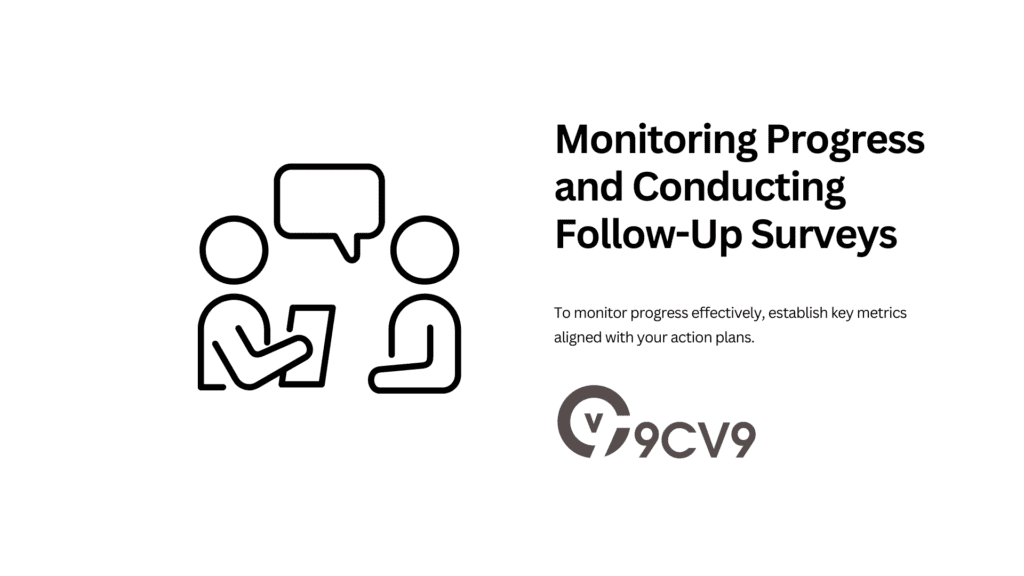
But the journey doesn’t end there.
In this section, we will explore the importance of monitoring progress and conducting follow-up surveys to ensure the sustainability of your improvement initiatives.
Let’s dive into the realm of continuous feedback and ongoing enhancement.
Step 1: Establishing Key Metrics – Tracking the Path to Success
To monitor progress effectively, establish key metrics aligned with your action plans.
Define measurable indicators that reflect the desired outcomes of your initiatives.
These metrics could include employee engagement scores, turnover rates, productivity measures, or customer satisfaction levels.
Regularly track and analyze these metrics to gauge the impact of your improvement efforts.
By establishing clear metrics, you can objectively assess the effectiveness of your actions.
Step 2: Feedback Loops and Pulse Surveys – Nurturing Continuous Improvement
Feedback is a powerful tool for driving continuous improvement.
Implement feedback loops within your organization to capture ongoing insights from employees.
This can be done through pulse surveys, which are shorter and more frequent surveys designed to track progress and gather timely feedback.
Pulse surveys allow you to assess employee satisfaction, monitor the effectiveness of implemented changes, and identify areas that may require further attention.
By nurturing a culture of continuous feedback, you empower employees to contribute to the ongoing enhancement of their work environment.
Step 3: Regular Check-Ins and Listening Sessions – Fostering Engagement and Trust
In addition to pulse surveys, schedule regular check-ins and listening sessions with employees. These can take the form of one-on-one meetings, team discussions, or town hall sessions. Use these opportunities to gather qualitative feedback, address concerns, and understand the evolving needs of your workforce. By actively listening to employees and valuing their input, you foster engagement and trust. These interactions provide valuable insights that can inform future improvement initiatives.
Step 4: Evaluating Action Plan Effectiveness – Fine-Tuning for Success
Regularly evaluate the effectiveness of your action plans in driving desired outcomes. Assess whether the implemented changes are producing the expected results and meeting the intended objectives. Analyze the data collected from ongoing surveys and feedback channels to identify areas that require further attention or adjustments. Use this evaluation to fine-tune your strategies and make informed decisions on refining your improvement initiatives. Adapting and evolving based on ongoing feedback ensures your efforts stay aligned with the evolving needs of your organization.
Step 5: Conducting Follow-Up Surveys – Revisiting Employee Perspectives
Periodically conducting follow-up surveys allows you to revisit employee perspectives and gather fresh insights.
These surveys can focus on specific areas or themes identified in previous surveys or address new topics of interest.
By regularly checking in with employees, you demonstrate your commitment to their well-being and engagement.
The data collected from follow-up surveys can help measure the impact of implemented changes, identify emerging trends, and guide future improvement initiatives.
Monitoring progress and conducting follow-up surveys are integral to sustaining the journey of improvement.
By establishing key metrics, implementing feedback loops, conducting regular check-ins, evaluating action plan effectiveness, and conducting follow-up surveys, you ensure that your organization continues to evolve and thrive.
Remember, the process of improvement is ongoing.
Embrace the feedback from your employees, make data-driven decisions, and continually refine your strategies to create an environment that fosters growth, engagement, and success.
With the completion of this section, our comprehensive guide on developing and conducting employee surveys comes to an end.
May your commitment to continuous improvement propel your organization to new heights, enriching the experiences of your employees and driving lasting success.
Conclusion
You’ve reached the end of our whimsical journey on how to develop and conduct employee surveys.
We’ve covered everything from preparation and design to analysis and action, sprinkled with a touch of humor along the way.
Now, let’s wrap it up with a delightful blend of wisdom and wit.
Developing and conducting employee surveys may sound like serious business, but that doesn’t mean we can’t have a little fun along the way.
After all, who said surveys had to be dull and dreary?
We’ve infused our guide with a pinch of humor to keep you engaged and entertained throughout the process. After all, laughter is the best survey tonic.
We embarked on this adventure by preparing for the survey, just like brave explorers preparing for an expedition into the unknown.
We gathered our tools, mustered our courage, and charted the course for survey success.
Remember, preparation is the key to a smooth and rewarding survey experience.
Then, we ventured into the realm of designing effective surveys, crafting questions with the precision of a master wordsmith.
We learned that simplicity is the secret ingredient, ensuring that even the most caffeine-deprived employees can understand and answer with ease.
We added a dash of creativity to keep things interesting and engaging, because who doesn’t love a survey that puts a smile on their face?
Next, we discovered the importance of ensuring survey participation and confidentiality.
We navigated the treacherous waters of low response rates and breached confidentiality like skillful pirates protecting their treasure.
We assured employees that their anonymity was as secure as a secret hiding spot for their favorite snacks.
With our trusty compass in hand, we then set out to implement and conduct the employee survey.
We launched the survey like a rocket, sending reminders like carrier pigeons, and collected data like a team of data-hungry squirrels.
We treated the survey data like a precious gem, guarding it with our lives (and backup systems) to prevent any accidental mishaps.
After the exhilarating data collection phase, we embarked on the thrilling adventure of analyzing and interpreting survey data.
We transformed raw data into golden nuggets of insights, unveiling patterns and narratives like mystical fortune tellers.
We danced with numbers and immersed ourselves in the rich tapestry of qualitative feedback, all while keeping our wits about us.
But the adventure didn’t end there.
We took action based on survey insights, driving change like superheroes with capes made of feedback.
We engaged stakeholders, developed action plans, and communicated like skilled diplomats to ensure everyone was on board for the journey of improvement.
We embraced the power of data-driven decision-making, knowing that behind every survey question lies a world of possibilities.
And now, dear survey adventurers, we’ve reached the end of our remarkable quest.
We hope this guide has not only equipped you with the knowledge and tools to develop and conduct employee surveys but has also brought a smile to your face along the way.
Remember, surveys don’t have to be a dull chore; they can be an exciting and transformative experience for your organization.
So go forth, fearless surveyors, and unleash the magic of employee feedback.
Let it guide you on a path of continuous improvement, engagement, and success.
Embrace the power of surveys, but never forget to sprinkle a little humor and joy into your surveying endeavors.
Farewell, for now, brave survey adventurers.
May your surveys be fruitful, your data be accurate, and your workplace be filled with laughter and success.
Until we meet again on our next whimsical quest, happy surveying.
If you find this article useful, why not share it among your business manager and HR director counterparts, and also leave a nice comment below?
We at the 9cv9 Research Team strive to bring the latest and most meaningful data, guide, and statistics to your doorstep.
Also, read some of our awesome articles:
Quiet Promotions: What it is and How to Overcome it?
The Pros of Virtual Internships: What You Need to Know (Updated in 2023)































![Writing A Good CV [6 Tips To Improve Your CV] 6 Tips To Improve Your CV](https://blog.9cv9.com/wp-content/uploads/2020/06/2020-06-02-2-100x70.png)


